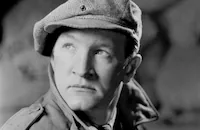Alaska Highway
Brief Synopsis
Cast & Crew
Frank Mcdonald
Richard Arlen
Jean Parker
Ralph Sanford
Bill Henry
Joe Sawyer
Film Details
Technical Specs

Synopsis
In February, 1942, builder Blair Caswell recommends his friend Pop Ormsby's road building company for a contract with the United States government to help build the new Alaska highway. The project has been given top priority since the bombing of Pearl Harbor, because the U.S. wants to set up defense outposts in Alaska. In accordance with the terms of the contract, Ormsby workers enlist in the U.S. Army Engineering Corps. Pop's son Woody, however, prefers to enlist for combat duty, while Woody's brother Steve, who has been following in his father's footsteps, stays on to work with Pop. Before the company heads for Alaska, Woody falls in love with Ann Caswell, Blair's daughter, unaware that his brother has been dating her. Ann genuinely falls in love with Woody, but is disappointed that he does not see the merit of the Engineering Corps. When Ormsby and company finally arrive in Dawson Creek, Canada, where they are to begin excavation for the highway, Woody and his pal, Frosty Gimble, are waiting to join them. The crew begins the hard labor of clearing forests and dynamiting rock to make way for the highway. When Steve nearly falls from a cliff, he is forced to drop his bag of dynamite for his own safety, and Woody saves his life. Later, Woody confesses to Ann that he returned only because he is in love with her, and she reciprocates his affection. Steve becomes embittered when he sees the pair together and requests a transfer, but Pop talks the brothers into suppressing their feud. The arduous work continues, but Blair puts pressure on Pop because the teams working their way south from Alaska are moving faster than the Ormsby teams. Pop then reprimands Woody because he is clearcutting too slowly, and Woody confronts Steve, betting one month's salary that he can clear more territory with a bulldozer than Steve can. Steve and Woody's reckless competition results in the injury of their comrade, Hank Lincoln. Pop now angrily approves Steve's request for a transfer, and Blair tells Ann that she must do what she can to resolve the situation, or they may lose Steve forever. As a result, Ann sends for Woody, who goes to her cabin thinking she is seeking a romantic rendezvous. After stoking the fire in the fireplace, Woody is shocked when Ann informs him that she is calling off their romance. When he opens the door to leave, Woody finds a raging forest fire outside the cabin, caused by embers from Ann's chimney. Woody leads Ann to safety, but Frosty is severely burned when a gas can he is moving explodes, and he dies the next day. Because of the fire, Steve's request for a transfer was never delivered, and Woody now decides to transfer. However, as he is leaving, a landslide occurs where the crew is working, and Woody and Pop rush to the scene. Steve is buried in a landslide while trying to rescue his co-worker, Roughhouse, and Pop and Woody rush to rescue both men, just before a huge tree crashes down. With all the men safe, Ann rushes to Woody's side, and Steve good-naturedly resigns himself to the fact that they are in love. The Engineer Corps doubles their efforts, and after six months of work, the northbound team meets the southbound team. The Alcan Highway is officially opened on 20 Nov 1942 as army convoys drive northward.

Director
Frank Mcdonald
Cast

Richard Arlen

Jean Parker
Ralph Sanford

Bill Henry

Joe Sawyer

Eddie Quillan
Harry Shannon
Edward Earle
Keith Richards
John Wegman
Crew
Charles S. Althouse
Ben Berk
Lewis R. Foster
Fred Jackman Jr.
Charles Kerr
William H. Pine
Freddie Rich
Maxwell Shane
F. Paul Sylos
William C. Thomas
William Ziegler

Film Details
Technical Specs

Quotes
Trivia
Notes
The film opens with the following written acknowledgment: "The producers are especially grateful to the Province of Alberta, Canada, for authentic scenes filmed on the Alcan Highway." The following written dedication also appears on the film: "For the U.S. Engineer Corps-the officers and men, who slashed the Alcan Highway through in time to protect our Alaskan outposts-this picture is a token of respect and admiration. It had to be done-and they did it!" The Alaska Highway, originally called the Alcan Highway, was constructed between March and November 1942 by the U.S. Army as a military and public road. A PM (Journal) magazine review lambasted the filmmakers for ignoring the fact that of the seven regiments that worked on the Alaska Highway, three were comprised of black soldiers. Noting that when the southbound and northbound bulldozers met at the completion of the highway, one of the bulldozers was manned by a black soldier, Corporal R. Sims, Jr., the reviewer commented: "Now wouldn't you think that a major American film studio, after the pledge of Hollywood to treat the Negro with fairness and honesty in films, would seize upon an opportunity like this to show the world the American Negro sharing equally with his white fellow-soldier in this epochal moment in breaking down the barriers of the world? Wouldn't you think that the passion for historical accuracy that Hollywood likes to plume itself for would dictate that this scene be faithfully recorded for posterity in any film which presumes to usurp the title Alaska Highway?...Not in this lily-white Paramount version of Pan-American history." Other reviews note that the filmmakers obtained footage of the actual construction of the highway for use in the film. A pre-production news item in Hollywood Reporter reported that a camera crew filmed highway construction in Azusa, CA, for possible use in the film. Reviews variously list John Wegman's character name as "Swithers" and "Swithens."












